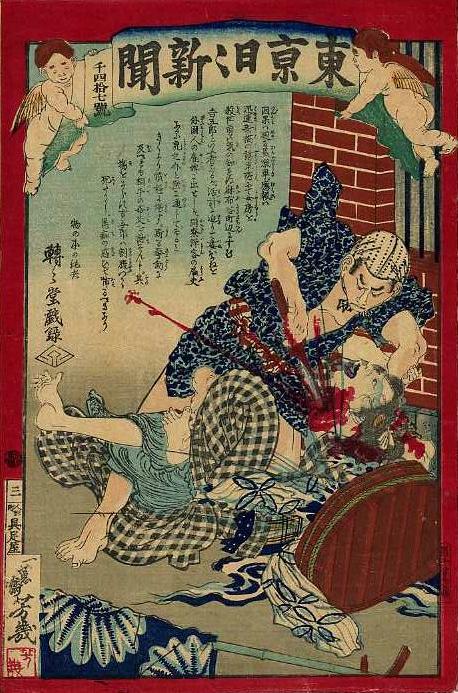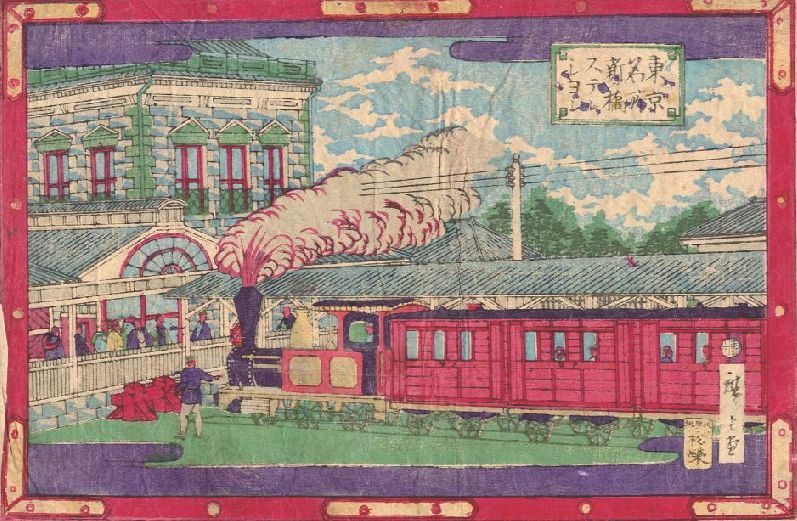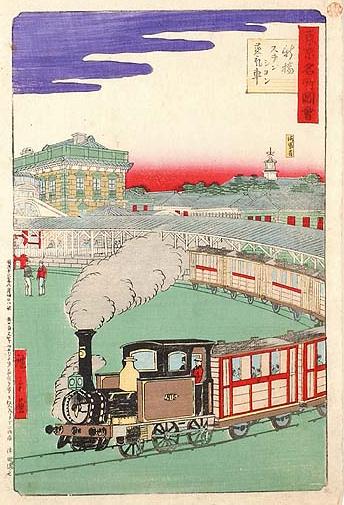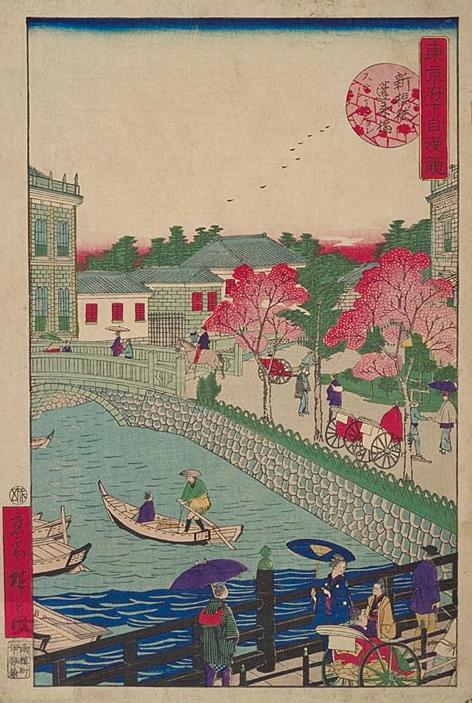
|
|
Yosha Bunko
|
Tokyo nichinichi shinbun
No. 1047 (3)
1875-06-22 (1875-08)
Man and adulterous wife and self
See another version of this story in
Yubin hochi shinbun Nishikiga No. 9.
"Cause-and-effect is a land steamer that goes around. And retribution was swift at the station in Shinbashi where a man called Kichigoro killed his wife. He lived in the vicinity of Tanimachi in Azabu and did not know feelings. Pressed for money to live on, he sent his wife Okane to work as a maid for an outlander, and she secretly took up with Toranosuke, who was the servant of the same overseas visitor (alien) [graphs=ijin, reading=yokyaku]. After hearing there was [another man] he could not contain his rage, and having come to such an act [of killing his wife], he struck and injured the opponent man (adulterer) [graphs=kanpu, reading=otoko]. Not leaving the place, Kichigoro cut and ripped his belly [graphs=kappuku, reading=harakakiyabutte] and died. The perplexity of ignorance is truly terrifying [guchi no madoi zo osoru beki nari]."
Tentendo
[Translated by William Wetherall]
|
Cause-and-effect . . . goes around
Tentendo has substituted land steamer for wheel in the phrase cause-and-affect [fate, fortune] is a wheel that goes around or "ingwa wa megurumu oguruma" (���ʂ͉�鏬��). The phrase that immediately follows is expected, but Tentendo writes ���� (�ނ���) �n�v�� (�͂₫) or "mukui wa hayaki", and the "ki" makes retribution is swift attributive to Shinbashi station.
This is a good example of the double bind of grammar and narrative style in translation. Translating only the grammar would result in something like "As for the man who killed his wife at Shinbashi station, where fate was a steam train that went around, and retribution was swift, he . . . ." But translating Tentendo's narrative style requires fidelity, both to the order in which he presents the elements of his story, and to the rhythms in which he makes these elements flow in the stream of his oration.
As Sato Kenji points out, "the opening with the 7-5 phrasing beginning 'Inga wa meguru okujouki, mukai wa hayaki shinbashi no . . .' sounds nice and the rhythm is pleasant to the ear" (Nyuusu no tanjo).
"7-5 phrasing" refers to the number of morae (not syllables) in phrases that alternate 7-5-7-5-7 morae. This alteration harks back to the oral tradition of the longer epic poems recorded in the 8th-century anthology Man'yoshu.
The first several lines of Tentendo's narration follow this old and familiar pattern.
7 -- ingwa wa meguru
5 -- okujouki
7 -- mukui wa hayaki
5 -- shinbashi no
7 -- suteishon nite
Tentendo wrote "steam train" or "jokisha" (���D��), but he glossed the characters "okujoki" (�������悤��) or "land steamer" (�����C) in order to get the rhythm he wanted. He also used a contemporary abbreviation for "steamship on land" or "oku no jokisen" (���̏��C�D). Later the name for this new mode of transportation called "jokisha" was shortened to just "kisha" (�D��), the forerunner of today's "electric trains" or "densha" (�d��).
The closing blames the murder-suicide on an affliction (madoi) of ignorance (guchi), which in Buddhism is one of the three poisons (doku) or perplexions (bonno) of the spirit, the other two being avarice (donyoku) and malice (shinni). This brings the story full circle to the opening theme that there is no escaping the effects of cause.
station in Shinbashi
The first train in Japan was built between Yokohama and Shinbashi. The Yokohama-Shinagawa leg began operations on 13 June 1872 (Meiji 5-5-8) after a ceremony the previous day. Service to the terminal at Shinbashi, constructed at Shiodome, then much closer to the shore of Tokyo bay, began on 15 October (Meiji 5-9-13), again after a ceremony the previous day.
The line was built to accommodate the movement of people and goods between Yokohama, where foreign ships arrived, and Tsukiji, where the foreign settlement and hotels for foreigners had been built in Edo. Shinbashi station was built on land obtained by forcefully relocating the residences of several shizoku and other families and shipping agents in the area.
What today is called Shinbashi "eki" (�w) was called Shinbashi "teishajo" or "stop-train-place" (��ԏ�). Tentendo wrote "keishajo" or "rest-train-place" (�e�ԏ�), but glossed this "suteishon" (���Ă������) -- a rare example of a kanaization of an English word in a news nishikie story.
Shinbashi was the terminal of the Tokkaido line until 1914 when Tokyo station was built. A new station was also built at Shinbashi, where the line was shifted a bit. The old station was torn down and the yard converted to a freight terminal called Shiodome-eki.
By the 1980s the yard was no longer being used and was sold for commercial development. Remnants of the original station were excavated in the 1990s when the site was made a national monument. A restored "Kyu Shinbashi Teishajo" now stands a couple of minutes walk from the present station. In the building is a railway history exhibition and a restaurant.
|
The Linguistic Universe of Shinbashi Sutenshon
|
Hiroshige III, Train Buff and Linguistic
Hundreds of nishikie celebrated the coming of steam trains and the stations they plied between. Dozens feature Shinbashi Station. Hiroshige III (c1843-1894) alone did several -- after marrying the divorced wife of Hiroshige II and assuming the mantle of his old-mentor and new father-in-law.
Hiroshige III did enough prints of trains arriving at, leaving, or just blowing steam at Shinbashi station to qualify as a true railroad buff. For others, too, trains were a fascinating development, and the buzzword of the day was "station".
In the title cartouches of the prints he did involving Shinbashi, Hiroshige III rendered "station" as "sutenshon" (�X�e���V����). Moreover, he grouped the kana in several ways, most of which graphically distinguish "suten" and "shon" as distinct syllables.
At least one Hiroshige III's Shinbashi prints appeared before Tentendo's rendition of "station" as "suteishon" (���������), and the other prints are contemporary. Here we will look at the prints, and then examine a few related linguistic issues -- like clustering of kanji, kana, and hangul, morae versus syllables -- and, believe it or not, information density.
|

|
|
Copped from Kanbara Bunko
|
c1870s
suten / shon
syllables written on
different lines vertically
Drawer: Hiroshige III
Carver: Matsuei
Series: Tokyo meisho
Title: Shinbashi suten / shon
|

|
|
Copped and cropped from Eldreds
|
c1870s
suten / shon
syllables written on
different lines vertically
Drawer: Hiroshige III
Series: Tokyo meisho
Title: Shinbashi sutenshon jokisha
|
1875
sutenshon
syllables written on
same line horizontally
Drawer: Hiroshige III
Series: Tokyo meisho no uchi
Title: Shinbashi sutenshon jokisha tetsudo zu
|

|
|
Copped and cropped from Nishigaki Bunko
|
1874-5
sutenshon
syllables written on
same line vertically
Drawer: Hiroshige III
Series: Tokyo fuka jiman kurabe
Title: Shinbashi yori Horaibashi suten-shon
|

|
|
Copped and cropped from Nishigaki Bunko
|
1875-8
suten / shon
syllables written as
clusters on same line horizontally
Drawer: Hiroshige III
Series: Tokyo meisho
Title: Shinbashi suten / shon jokisha no zu
|
Clustering of Kanji, Kana, and Hangul
Hundreds of new characters have been created in Japan by clustering kanji. �� (hataraku) meaning "work" from �l (person) and �� (move). �� (tooge) meaning "mountain pass" from �R (mountain), �� (up), and �� (down). �H (Kume), a name, from �v�� (Kume). The list is long, and includes a series of kanjiesque metric units.
Kana, representing recently imported words, are also clustered in a block the size of a single character. A common example today is "meetoru" (�b). Here the cluster is written left-to-right and top-to bottom. It can also be written top-to-bottom and left-to-right.
Kana and Hangul
The clustering of the kana for "sutenshon" is reminiscent of Korean hangul, but the species of script are entirely different. About the only other thing the two scripts have in common is that the order of their sounds in dictionaries is based on Sanskrit.
Kana represent morae, and all kana morae except the single vowels and "-n" represent two phonemes. Hangul elements, in contrast, represent phonemes that can be readily clustered in syllables reading left-to-right and top-to-bottom. A hungul cluster usually forms a syllable, but kana are generally not syllabic.
Morae and Syllables
The kana clusters in Hiroshige's nishikie only appear to be syllabic. Graphically, they represent only morae, unlike hangul, which represent phonemes and syllables.
While "shon" is graphically two morae which represent one syllable, "suten" is graphically three morae which represent one or two syllables, depending on dialect. In Tokyo, "suten" was probably pronounced "sten", whereas in Kyoto it might have been "suten".
Syllables, though, don't matter in the world of Japanese poetics. All that matters is morae, and kana represent morae.
Whether Hiroshige III's "sutenshon" or Tentendo's "suteison" are two syllables in Tokyo or three in Kyoto, they are five morae when counting what matters in Japanese meter -- su, te, n/i, sho, n.
Information Density
If you write a 17-syllable poem in English, it contains a lot more information than a 17-morae poem in Japanese -- for a very simple reason. The information density of English syllables much higher than the information density of Japanese morae.
Most basic English words consist of one or two, seldom more, syllables. Most basic Japanese words consist of two or three, and not infrequently more, morae. So the average amount of information per English syllable is greater than the average amount of information per Japanese mora.
Musical Space
Translate Japanese lyrics into English, one-to-one in terms of words, and then work the English into the musical space. As you try to fit the English to the music, you will find you don't have enough syllables. There will be a lot of silence, and you will have to pad the lyrics to fill out the space.
Translate English lyrics into Japanese, however, and you will face the opposite problem. Most likely there will be too many morae, and you will have to cut content in order to squeeze the original into the music.
Syncopation and Meter
English is a highly syncopated language -- the time given syllables is heavily influenced by stress. Whereas Japanese is comparatively metronomic -- the time given a mora is also affected by stress, but not nearly as much.
As an exercise, listen to how Japanese lyrics are sung, to various kinds of music, and ask yourself -- Is Japanese, when sung, syncopated or metronomic?
The wheel of fortune . . .
Then ask yourself -- How come you began reading about a murder at Shinbashi station, where fate is a choo-choo train that comes and goes -- and ended up getting a lecture on music?
What could you have done in your past to deserve such retribution?
|
Print information
Size oban
Series: Tokyo nichinichi shinbun
Issue: 1047 [TNS 1875-6-22]
Number 3
Approval seal: 1875-8
Drawer: Ikkeisai Yoshiiku
Writer: Tentendo (Writer of the source of things)
Carver: Horiko Eizo
Publisher: Gusokuya (Ningyocho)
Principal sources
Yosha Bunko, Ono Collection, Ono 1972:168 (Plate 77), Sato 1999 (Nyuusu no tanjo).




